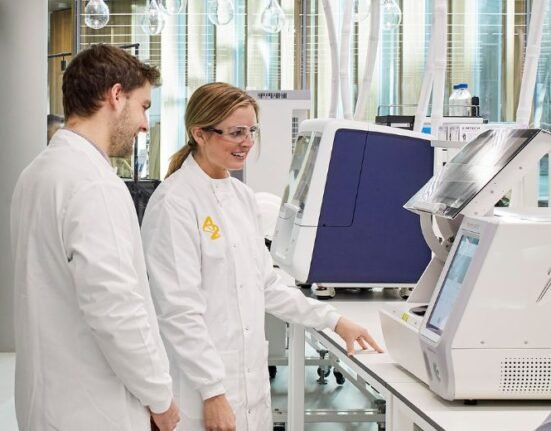HQ Team
September 11, 2023: An electronic device to endlessly monitor a transplanted organ’s temperature, to detect signs of the body’s rejection, has been developed by Northwestern University researchers.
This is the first electronic device to constantly monitor the health of transplanted organs in real-time compared to the existing intermittent, imperfect and sometimes invasive procedures.
At just 0.3 centimetres wide, 0.7 centimetres long and 220 microns thick, it is smaller than a pinky fingernail and about the width of a single hair.
The entire organ is encapsulated by a fibrous layer, called the renal capsule, which protects it from damage.
The device contains a highly sensitive thermometer, which can detect incredibly slight (0.004 degrees Celsius) temperature variations on an organ— and only the specific organ.
A body can reject a transplanted organ at any time — even decades later. Signs of rejection must be caught early to intervene and preserve the organ, according to the study published in Science journal.
Smartphone alert
When temperatures change, an alert is sent to a smartphone or tablet in real time.
When implanted inside the organ, the ultra-thin, soft implant can detect temperature irregularities associated with inflammation and other body responses that arise with transplant rejection.
While the primary studies were conducted with kidney transplants, the researchers assume it could also work for other organ transplants, including the liver and lungs and for other disease models.
The researchers first tested the device on a small animal model with transplanted kidneys and found the device detected warning signs of rejection up to three weeks earlier than current monitoring methods.
“This extra time could enable physicians to intervene sooner, improving patient outcomes and well-being as well as increasing the odds of preserving donated organs, which are increasingly precious due to rising demand amid an organ-shortage crisis,” according to the study.
Silent signs
The rejection signs of the transplanted organ are often silent, and patients might not experience symptoms, the study authors said.
“I have noticed many of my patients feel constant anxiety — not knowing if their body is rejecting their transplanted organ or not,” said Dr. Lorenzo Gallon, a Northwestern Medicine transplant nephrologist, who led the clinical portion of the study.
Northwestern’s John A. Rogers, a bioelectronics pioneer who led the device development, said it’s critical to identify rejection events as soon as they occur.
“If rejection is detected early, physicians can deliver anti-rejection therapies to improve the patient’s health and prevent them from losing the donated organ,” Mr Rogers said.
“In worst-case scenarios, if the rejection is ignored, it could be life-threatening. The earlier you can catch rejection and engage in therapies, the better. We developed this device with that in mind.”
Personalised dosing
“Each individual responds to anti-rejection therapy differently,” said Surabhi Madhvapathy, a postdoctoral researcher in Rogers’ laboratory and the paper’s first author.
“Real-time monitoring of the health of the patient’s transplanted organ is a critical step toward personalized dosing and medicine.”
There are more than 250,000 people in the US living with a transplanted kidney. The easiest way to monitor kidney health is by measuring specific markers in the blood.
By tracking the patient’s creatinine and blood urea nitrogen levels, doctors can gain insight into kidney function.
Creatinine and blood urea nitrogen levels can fluctuate for reasons unrelated to organ rejection, so tracking these biomarkers is neither sensitive nor specific, sometimes leading to false negatives or positives.
Biopsy ‘gold standard’
The current “gold standard” for detecting rejection is a biopsy, in which a physician uses a long needle to extract a tissue sample from the transplanted organ and then analyzes the sample for signs of impending rejection.
Invasive procedures like biopsies carry risks of multiple complications, including bleeding, infection, pain and even inadvertent damage to nearby tissues.
“The turnaround time can be quite long, and they are limited in monitoring frequencies and require off-site analysis,” Dr Gallon said.
“It might take four or five days to get results back. And those four or five days could be crucial in making a timely decision for the care of the patient.”
Northwestern’s new bioelectronic implant monitors something much simpler and more reliable —temperature.
Early warning
As temperature increases typically accompany inflammation, the researchers hypothesized that sensing anomalous temperature increases and unusual variations in temperature might provide an early warning sign for potential transplant rejection.
The animal study confirmed that. In the study, the researchers noticed that the local temperature of a transplanted kidney increases — sometimes as much as 0.6 degrees Celsius — preceding rejection events.
“Organ temperature fluctuates over a daily cycle under normal circumstances,” researcher Madhvapathy said.
“We observed abnormal higher frequency temperature variations occurring over periods of eight and 12 hours in cases of transplant rejection.”
The researchers are now testing the system in a larger animal model. They are also evaluating ways to recharge the coin cell battery so that it can last a lifetime.








